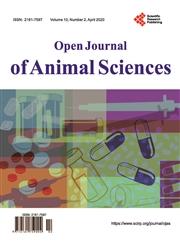Effect of Groundnut (Arachis hypogaea L.) Haulm and Maize Bran Mixture Supplementation on Growth and Carcass Characteristics Performance of Local Sheep Fed Pasture Hay Basal Diet
引用次数: 3
Abstract
The experiment was conducted to evaluate the effect of groundnut haulm and maize bran mixture supplementations on feed intake, digestibility, body weight gain and carcass characteristics of local sheep fed hay basal diet at Salga sheep farm in Assosa district, Western Ethiopia. The experiment was laid out in a randomized complete block design (RCBD) with four treatments consisting of six blocks with four animals per block based on their initial body weight of 20.12 ± 0.05 kg (mean ± SD). Treatments comprised of feeding natural pasture hay ad libitum T1 = 0; T2 = 100% maize bran (MB); T3 = 50% MB and 50% Groundnut haulm (GNH), and T4 = 100% GNH. The amount of supplements offered was 300 g/day/animal on DM basis. The daily feed intake, daily body weight gain, feed conversion efficiency, dry matter and nutrient digestibility, and carcass characteristics parameters were measured during the experimental period. The study result indicates that the crude protein (CP) contents were 7.12% and 11.6%, and the neutral detergent fiber (NDF) contents were 67.9% and 57.5% for natural grass hay and groundnut haulm, respectively. The total DM intake was higher OM, and ADF digestibility in the control group (T1) was significantly lower than the supplemented groups (P < 0.001), but there is no significant difference between supplemented treatments (T2, T3, T4). The CP digestibility was the least in the control group (T1) than the supplemented (76 vs 85.5, 88.8 and 89.3 for T1, T2, T3 and T4, respectively). Furthermore, dressing percentage on slaughter weight and empty body weight basis and rib-eye muscle area were high for T4. Empty body weight and hot carcass weight were higher in T4 (27.5 and 15.2 kg) and T3 (25.5 and 14.1 kg) as compared to the control group (19.8 and 10.3 kg), respectively. Similar to biological performance, the economic analysis also showed that supplementation with T4 resulted in better returns compared to others. Thus, it can be concluded that supplementation in general improved animal performance. Among the supplements, T4 is biologically optimum and economically feasible.花生(arachhis hypogaea L.)的作用饲粮中添加秸秆与玉米糠混合料对地方羊生长和胴体性能的影响
本试验旨在研究在埃塞俄比亚西部阿索萨地区Salga绵羊养殖场饲粮中添加花生糠和玉米糠混合物对当地绵羊采食量、消化率、增重和胴体特性的影响。试验采用随机完全区设计(RCBD), 4个处理,6个区,每区4只动物,初始体重为20.12±0.05 kg (mean±SD)。随机饲喂天然牧草处理T1 = 0;T2 = 100%玉米麸皮(MB);T3 = 50% MB和50%花生量(GNH), T4 = 100% GNH。饲粮添加量为300 g/d /只。试验期间测定日采食量、日增重、饲料转化效率、干物质和营养物质消化率以及胴体特性参数。研究结果表明,天然草干草和花生秸秆粗蛋白质(CP)含量分别为7.12%和11.6%,中性洗涤纤维(NDF)含量分别为67.9%和57.5%。对照组(T1) DM总摄取量较高,ADF消化率显著低于各添加组(P < 0.001),而各添加组(T2、T3、T4) ADF消化率差异不显著。对照组(T1)粗蛋白质消化率最低,分别为76比85.5、88.8和89.3 (T1、T2、T3和T4)。T4的屠宰率和空体重屠宰率及肋眼肌面积较高。T4期空体重(27.5和15.2 kg)和T3期热胴体重(25.5和14.1 kg)分别高于对照组(19.8和10.3 kg)。与生物学性能类似,经济分析也表明,补充T4比其他补充剂带来更好的回报。由此可见,在一般情况下,添加饲粮可提高动物生产性能。在这些补充剂中,T4在生物学上是最佳的,在经济上是可行的。
本文章由计算机程序翻译,如有差异,请以英文原文为准。
求助全文
约1分钟内获得全文
求助全文

 求助内容:
求助内容: 应助结果提醒方式:
应助结果提醒方式:


